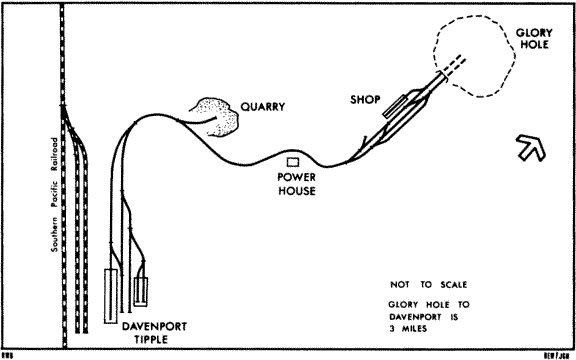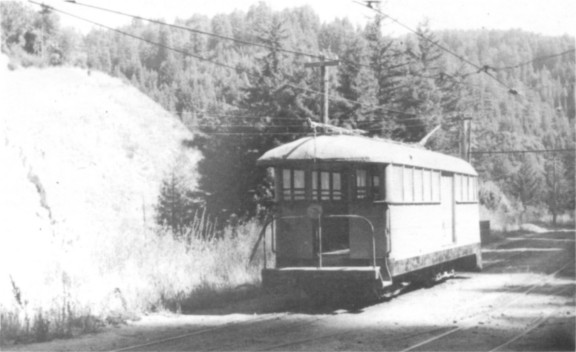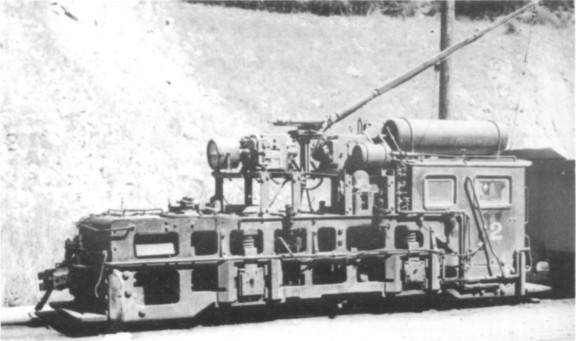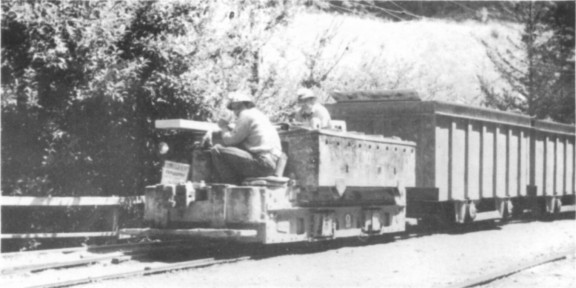
| THE INDUSTRIAL RAILWAY RECORD |
© OCTOBER 1968 |
SANTA CRUZ CEMENT
ROBERT W. BROWN
(Photographs by the Author)
During California's early development the Pacific Ocean served as the main north and south transportation link. All along the Pacific Coast small ports were established for the loading and unloading of goods. The vessels that put into these ports were loaded by chutes or overhead lines and in some cases from high wharves erected for the purpose. One such wharf was located south of San Francisco at Davenport, California.
Back in 1902 the Standard Portland Cement Company was organized to quarry limestone for the cement needed by the rapidly growing state of California. In 1905 a separate company was incorporated called the Santa Cruz Portland Cement Company and a standard gauge quarry railway was built. This line was completed in 1906 and ran from the open pit quarry in the hills behind Davenport down to the cement plant near the town. Two Porter 0−4−0 saddle tank locomotives worked the line; one (Porter 3578 of 1906) was a 35−ton model, the other (Porter 4390 of 1909) weighed 45 tons. A narrow gauge line worked within the quarry itself.
In 1923 the Company purchased from the Alaska Gastineau Mining Company an entire narrow gauge mining railway, located in Alaska, which was moved to California to replace the standard gauge equipment at Davenport. The standard gauge right of way was used but many of the bridges were filled in. The new line was laid with 60lb rails to three foot gauge.
Opened for operation in 1924, it is still at work today. There are two 18−ton four-wheeled electric locomotives built by Baldwin in 1914, each having two 90hp Westinghouse motors and a trolley pole for overhead wire pick up. Electricity at a line voltage of 600dc is produced by a generating set operating at 2,200 volts ac. In addition, there are three or four four-wheeled battery electric locomotives for service at the quarry, and sixty-five 12−ton four-wheeled rock cars which have Westinghouse air brakes.
The quarry consists of a funnel-like "Glory Hole" where the limestone is blasted away from the high cliffs into a huge cement hopper. Rock cars are pushed under the hopper by a battery locomotive and filled with limestone. The battery loco pulls them out, and is then exchanged for an overhead pickup loco for the three mile run to the tipple at the main plant in Davenport. The cars are emptied by a rotary dumper at the plant and then sent back for another load. 0n my visit to the line there was a train about every twenty minutes.
The miners ride back and forth from work in a rather historic piece of equipment. In 1942 the company purchased the remains of a three foot interurban car from the Pacific Coast Railroad which was used in the construction of a company "streetcar" which retained none of its former beauty. It is a fascinating car to watch nevertheless.
In 1956 the company was purchased by the Pacific Cement & Aggregates, Inc, and became their Santa Cruz Cement Company Division, The railway is soon to be replaced by an automatic conveyor system so its days are numbered.


The streetcar in typical scenery.

Overhead pickup locomotive number 2 on the main line.

Battery shunter number 2 near the Glory Hole.
Acknowledgements are due to the April 1963 issue of the "Western Railroader" for certain items of technical information.